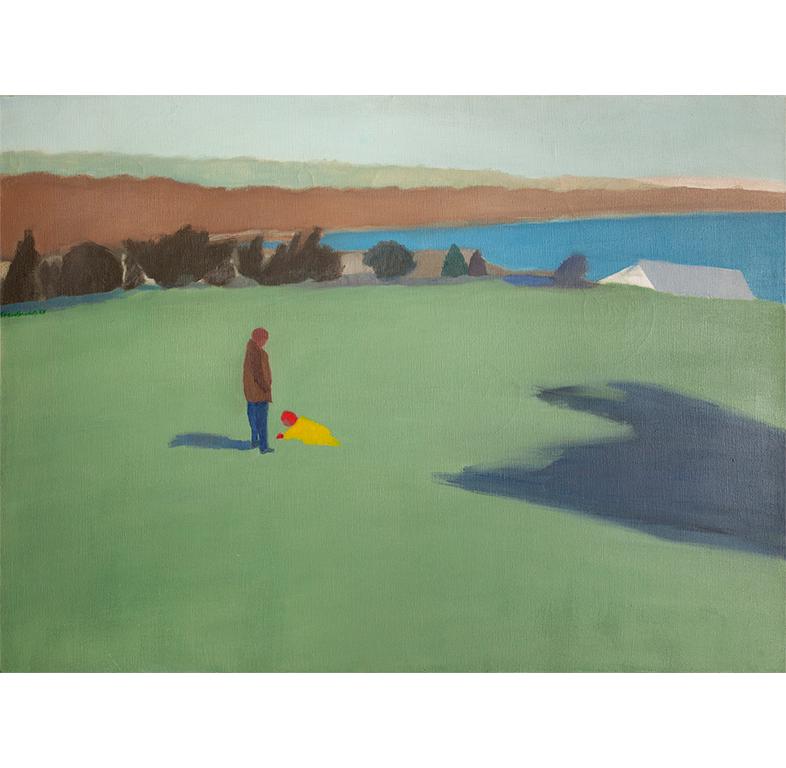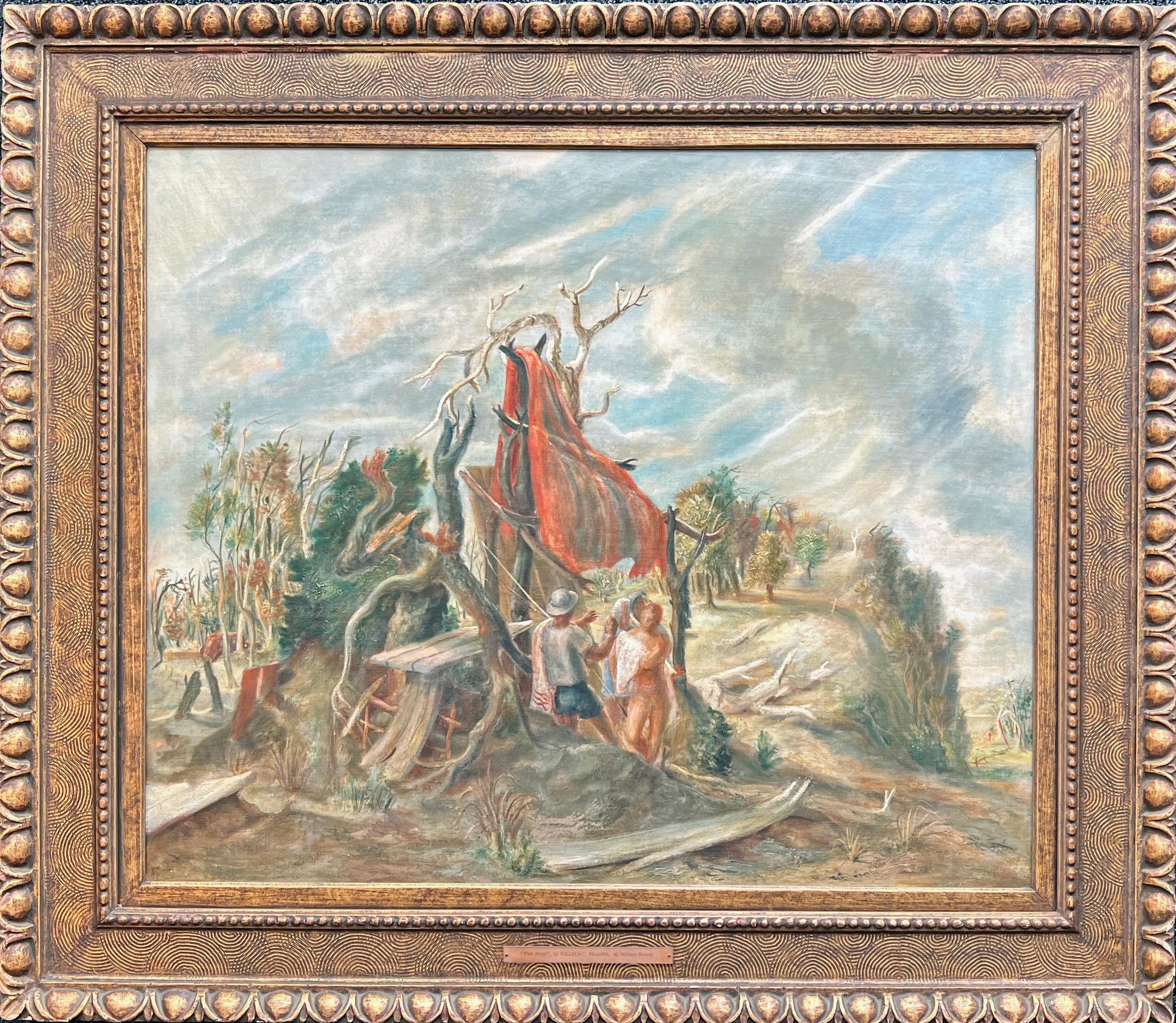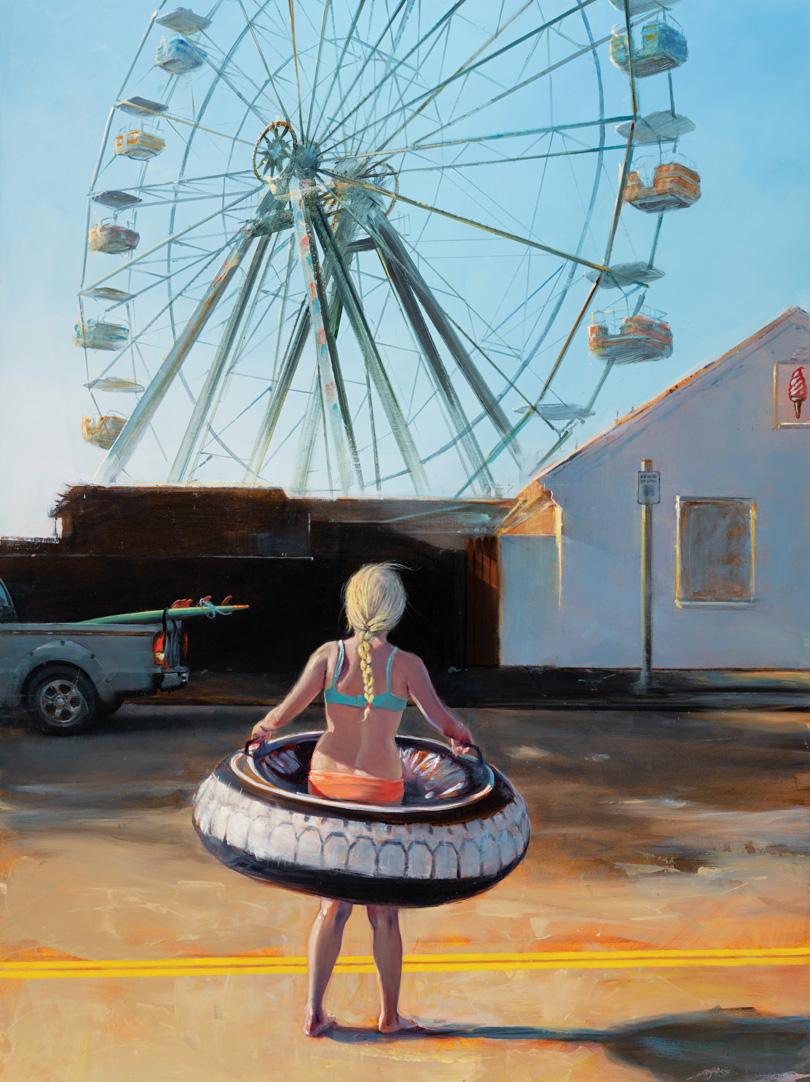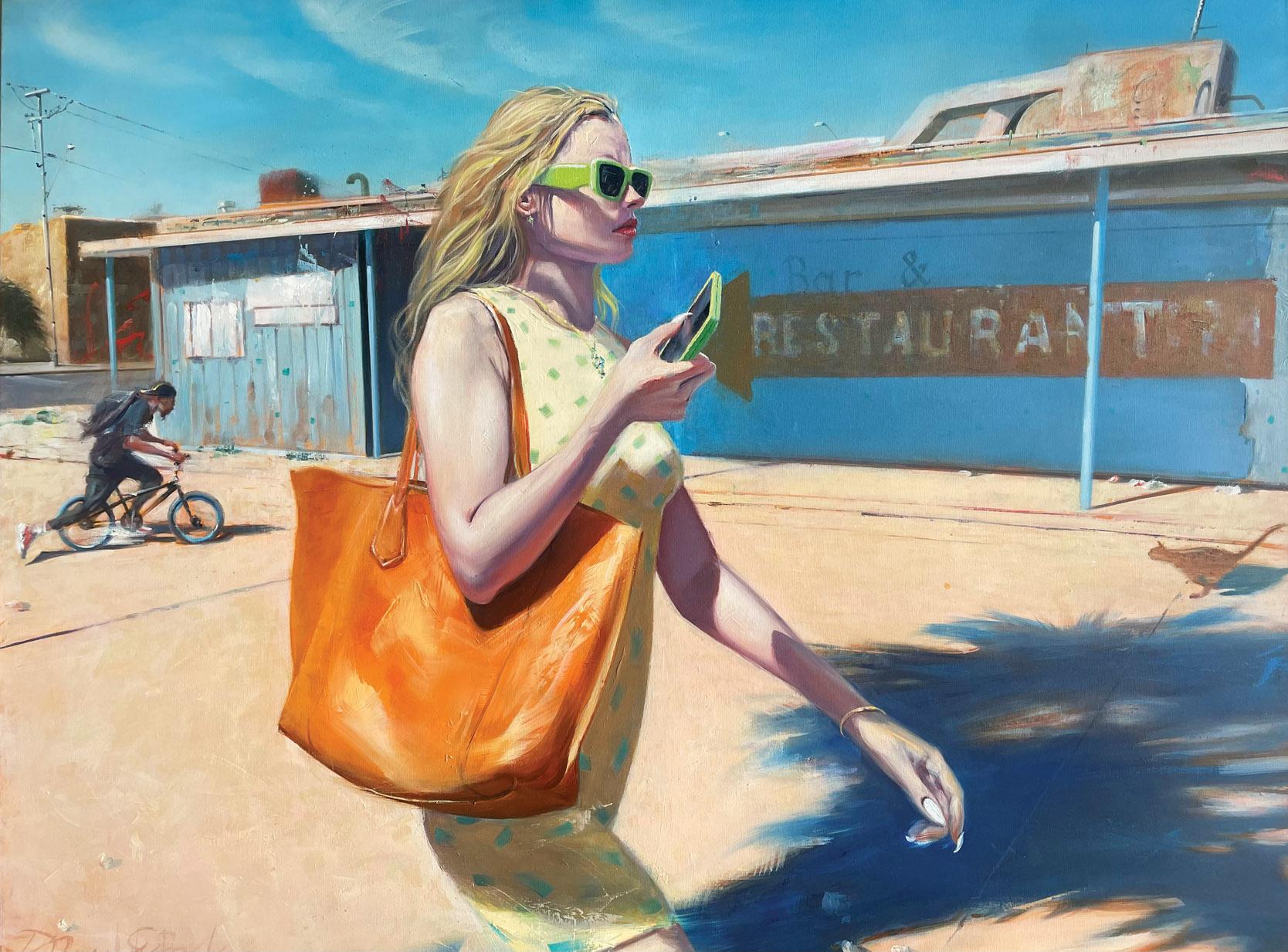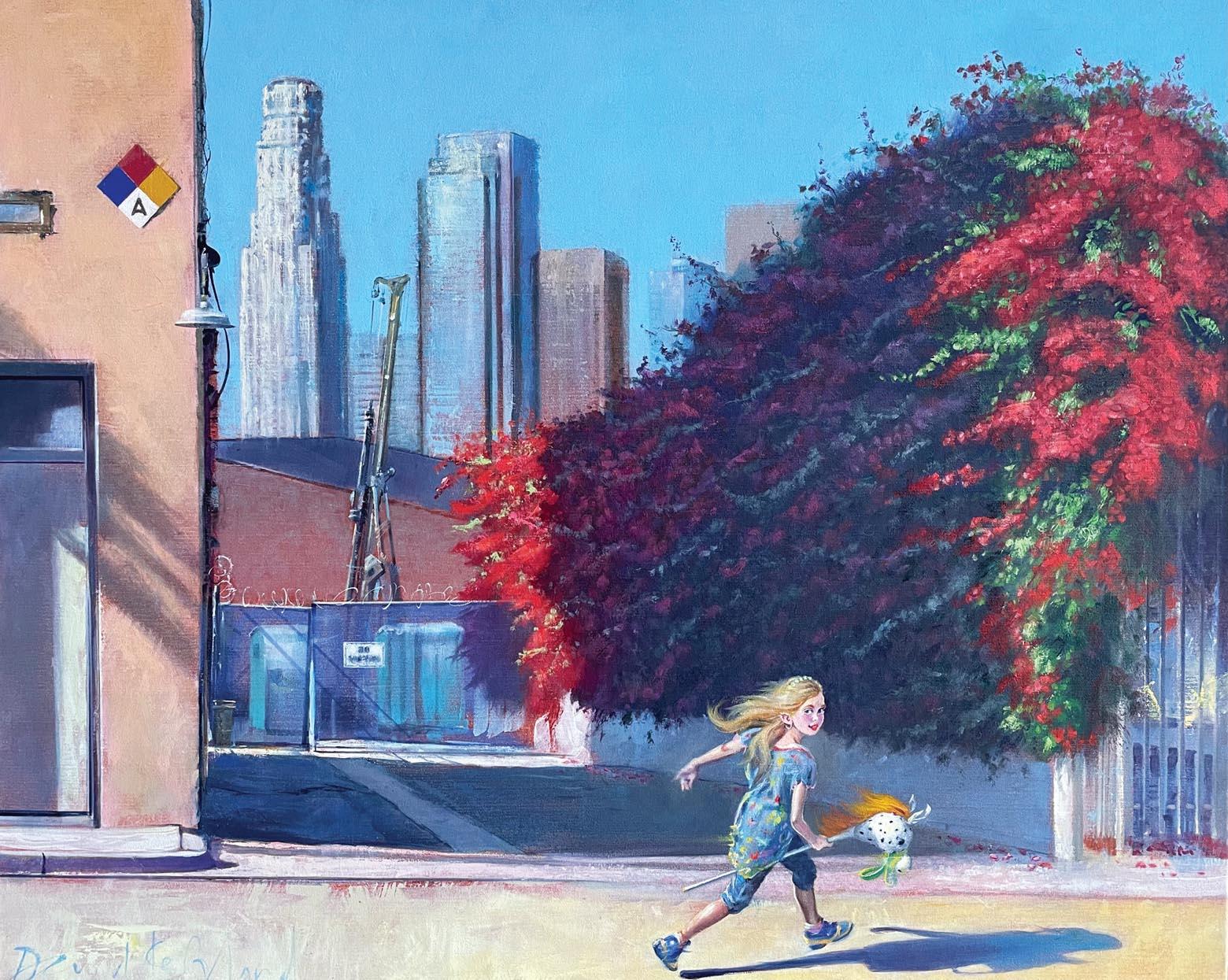Items Similar to Social Realist Street Scene Modernist Landscape Oil Painting
Want more images or videos?
Request additional images or videos from the seller
1 of 7
Paul ZimmermanSocial Realist Street Scene Modernist Landscape Oil Painting1953
1953
About the Item
Oil Painting Mid 20th century, signed P. Zimmerman Reminiscent of the Mid Century Social Realist and WPA works of Ben Shahn this captures an architectural street scape.
Paul Zimmerman, N.A. (1921-2007). Paul W. Zimmerman was an internationally known artist and professor emeritus of the Hartford Art School. Born April 29, 1921, in Toledo, Ohio, the son of Robert Frazee and Ethel Pearl (Cramer) Zimmerman, Zimmerman passed away December 15, 2007 in Hartford, Connecticut.
Always a great admirer of Cezanne, Zimmerman was particularly drawn to the French painter's innovations regarding space and the fracturing of the traditional picture plane.
In 1947, Henrik M. Mayer, Director of the Hartford Art School at the time, invited Zimmerman to join the faculty. What began as a two-year agreement became a 40-year career. He remained true to his personal artistic vision throughout his long distinguished career and continued to work in his studio, remain engaged in the artistic community and teach part-time at the West Hartford Art League, West Hartford, CT throughout his retirement.
A prolific landscape painter, Zimmerman's oils and watercolors are found in numerous museum, corporate and private collections, including the Connecticut Academy of Fine Arts; the Springfield Museum of Fine Arts; the Pennsylvania Academy of Fine Arts; the Wadsworth Atheneum; The Slater Museum; the University of Notre Dame; Lehigh University; First New Haven National Bank and United Technologies Corporation. He was also commissioned to design a series of murals for Chase Manhattan Bank in New York. Zimmerman is listed in Davenport's, A Grand Tradition: Art and Artists of the Hoosier Salon, and Who was Who in American Art. Born in Toledo Ohio in 1921, he studied at the John Herron Art School and earned his BFA degree in 1946. His work has been represented by galleries in New York, Maine, Connecticut, Ohio, etc. He was an associate member of the National Academy of Design in 1959 and became a full member of the National Academy of Design in 1972. Zimmerman was also a member of the Connecticut Academy of Fine Arts and the Connecticut Water Color Society. His work was exhibited at the famed Hoosier Salon Indiana in 1944, 1948, 1950, 1952, 1955. Also his work was exhibited at the Corcoran Gallery, John Herron Art Musuem Indianapolis, University of Illinois, Pennsylvania Academy of Fine Arts annuals, Connecticut Water Color Society, the National Academy of Design, and the New Britain Museum of American Art. He won many awards such as: The Hallgarten Prize (1954); The Wallace Truman Prize (1956); The Salmagundi Club Prize from the National Academy (1962); Second Prize Butler Art Institute (1958); Members Prize, Boston Arts Festival (1964); The Patrick B. McGinnis Award, Berkshire Arts Festival (1961); Second Prize at Chautauqua (1955); The Howard Penrose Award, Connecticut Academy (1959); Third Prize, Kearney Memorial Regional Exhibition Milwaukee WI (1964); The Gertrude Melcher Springer Prize at the Indiana Exhibition (1959); First Prize, Connecticut Watercolor Society, the J. I. Holcomb Prize from the Herron Art Musuem (1955), and many others. Throughout his extensive career, Paul received well over 86 awards in both regional and national exhibitions. He was also elected a member of the National Academy of Design. His work can be seen in numerous museums, including the Slater Memorial Museum, Springfield Museum of Fine Arts, Pennsylvania Academy of Fine Arts, Wadsworth Atheneum Museum of Art, University of Notre Dame, Lehigh University and Houston Museum of Fine Art, as well as in many corporate and private collections.
- Creator:Paul Zimmerman (American)
- Creation Year:1953
- Dimensions:Height: 16 in (40.64 cm)Width: 36 in (91.44 cm)
- Medium:
- Movement & Style:
- Period:
- Condition:unframed.
- Gallery Location:Surfside, FL
- Reference Number:1stDibs: LU38212530542
About the Seller
4.9
Platinum Seller
These expertly vetted sellers are 1stDibs' most experienced sellers and are rated highest by our customers.
Established in 1995
1stDibs seller since 2014
1,548 sales on 1stDibs
Typical response time: 1 hour
- ShippingRetrieving quote...Ships From: Surfside, FL
- Return PolicyA return for this item may be initiated within 3 days of delivery.
More From This SellerView All
- Large Modernist Oil Painting 1940s, Judaica Hasidic Shtetl Wagon Driver WPA EraBy Emanuel Glicenstein RomanoLocated in Surfside, FLGenre: Modern Subject: Landscape with figure of horse, driver and wagon Medium: Oil Surface: wood Board EMANUEL ROMANO Rome, Italy, b. 1897, d. 1984 Emanuel Glicen Romano was born in Rome, September 23, 1897. His father Henryk Glicenstein was a sculptor and was living in Rome with his wife Helena (born Hirszenberg) when Emanuel was born. His father obtained Italian citizenship and adopted the name Enrico. Emanuel was brought up in Italy, Switzerland, Germany, England and Poland. In 1926 Emanuel Glicenstein Romano and his father sailed for New York. They briefly visited Chicago. Romano's sister, Beatrice, and mother only joined them in New York years later. Romano changed his name on his arrival to America and some have erroneously speculated that this was to avoid antisemitic discrimination. In truth, as the son of a highly-regarded artist, Romano changed his name to ensure that any success or recognition he would later attain, would be the result of nothing other than his own merit as an artist, and not on account of his father's fame. In 1936 Romano was worked for the WPA Federal Art Project creating murals. ( there were many jewish artists active with in the WPA period. notably Chaim Gross, Ben Shahn, Isaac and Moses Soyer, Abraham Rattner and many others. During and immediately after World War II, Romano created a series of allegorical works depicting graphic holocaust images that were held closely by the family until after his passing. One of these works is now on permanent display in the Florida Holocaust Museum in St. Petersburg Florida. Emanuel's father died in 1942 in a car accident before they could realize their shared dream of visiting Israel. In 1944 Romano, having completed his degree at the Pennsylvania Academy of Fine Arts and the Art Institute of Chicago, began teaching at the City College of New York. Romano moved to Safed, Israel in 1953 and established an art museum in his father's memory, the Glicenstein Museum. COLLECTIONS Indianapolis Museum of Art Metropolitan Museum of Art Boston Fine Arts Museum Fogg Museum Musée Nacional de France Recently his work has been added to the Florida Holocaust Museum collection. His notable works include his holocaust themed allegorical paintings as well as portraits of Marianne Moore, his father and William Carlos Williams...Category
1930s American Modern Figurative Paintings
MaterialsOil, Board
- Simka Simkhovitch WPA Artist Oil Painting Gouache American Modernist PowerlineBy Simka SimkhovitchLocated in Surfside, FLSimka Simkhovitch (Russian/American 1893 - 1949) This came with a small grouping from the artist's family, some were hand signed some were not. These were studies for larger paintings. Simka Simkhovitch (Симха Файбусович Симхович) (aka Simka Faibusovich Simkhovich) (Novozybkov, Russia May 21, 1885 O.S./June 2, 1885 N.S.—Greenwich, Connecticut February 25, 1949) was a Ukrainian-Russian Jewish artist and immigrant to the United States. He painted theater scenery in his early career and then had several showings in galleries in New York City. Winning Works Progress Administration (WPA) commissions in the 1930s, he completed murals for the post offices in Jackson, Mississippi and Beaufort, North Carolina. His works are in the permanent collections of the Dallas Museum of Art, the National Museum of American Art and the Whitney Museum of American Art. Born outside Kyiv (Petrograd Ukraine) into a Jewish family who owned a small department store. During a severe case of measles when he was seven, Simcha Simchovitch sketched the views outside his window and decided to become an artist, over his father's objections. Beginning in 1905, he studied at the Grekov Odessa Art School and upon completion of his studies in 1911 received a recommendation to be admitted to the Imperial Academy of Arts. Though he enrolled to begin classes in architecture, painting, and sculpture at the Imperial Academy, he was dropped from the school roster in December because of the quota on the number of Jewish students and drafted into the army. Simchovitch served as a private in the 175th Infantry Regiment Baturyn [ru] until his demobilization in 1912. Re-enrolling in the Imperial Academy, he audited classes. Simka Simkhovitch exhibited paintings and sculptures in 1918 as part of an exhibition of Jewish artists and in 1919 placed 1st in the competition "The Great Russian Revolution" with a painting called "Russian Revolution" which was hung in the State Museum of Revolution. In 1922, Simkha Simkhovitch exhibited at the International Book Fair in Florence (Italian: Fiera Internazionale del Libro di Firenze). In 1924, Simkhovitch came to the United States to make illustrations for Soviet textbooks and decided to immigrate instead. Initially he supported himself by doing commercial art and a few portrait commissions. In 1927, he was hired to paint a screen for a scene in the play "The Command to Love" by Fritz Gottwald and Rudolph Lothar which was playing at the Longacre Theatre on Broadway. Art dealers began clamoring for the screen and Simkhovitch began a career as a screen painter for the theater. Catching the attention of the screenwriter, Ernest Pascal, he worked as an illustrator for Pascal, who then introduced him to gallery owner, Marie Sterner. Simkhovitch's works appeared at the Marie Sterner Gallery beginning with a 1927 exhibit and were repeated the following year. Simkhovitch had an exhibit in 1929 at Sterner's on circus paintings. In 1931, he held a showing of works at the Helen Hackett Gallery, in New York City and later that same year he was one of the featured artists of a special exhibit in San Francisco at the California Palace of the Legion of Honor in Lincoln Park. The exhibit was coordinated by Marie Sterner and included four watercolors, including one titled "Nudes". He is of the generation of Russian Soviet artists such as Isaac Pailes, Serge Charchoune, Marc Chagall, Chana Orloff, Isaac Ilyich Levitan, and Ossip Zadkine. In 1936, Simkhovitch was selected to complete the mural for the WPA Post office project in Jackson, Mississippi. The mural was hung in the post office and courthouse in 1938 depicted a plantation theme. Painted on the wall behind the judge’s bench, “Pursuits of Life in Mississippi”, a depiction of black workers engaged in manual labor amid scenes of white professionals and socialites, was eventually covered over in later years during renovations due to its stereotypical African American imagery. Simka painted what he thought was typical of Jackson. His impression of pre-civil rights Mississippi was evidently Greek Revival column houses, weeping willow trees, working class families, and the oppression of African Americans. He painted African American men picking cotton, while a white man took account of the harvest and a white judge advised a white family, calling it Pursuits of Life in Mississippi. Though clearly endorsed by the government and initially generally well-received, the mural soon raised concerns with locals as the climate toward racial segregation began to change. The main concern was whether depictions that show African Americans in subjugated societal roles should be featured in a courtroom. The following year, his painting "Holiday" won praise at an exhibition in Lincoln, Nebraska. In 1940, Simkhovitch's second WPA post office project was completed when four murals, "The Cape Lookout Lighthouse and the Orville W. Mail Boat", "The Wreck of the Crissie Wright", "Sand Ponies" and "Canada Geese" were installed in Beaufort, North Carolina. The works were commissioned in 1938 and did not generate the controversy that the Jackson mural had. The main mural is "The Wreck of the Crissie Wright" and depicts a shipwreck which had occurred in Beaufort in 1866. "The Cape Lookout Lighthouse and the Orville W. Mail Boat" depicted the lighthouse built in 1859 and the mail boat that was running mail during the time which Simkhovitch was there. The boat ran mail for the area until 1957. "Sand Ponies" shows the wild horses common to the North Carolina barrier islands and "Canada Geese" showed the importance of hunting and fishing in the area. All four murals were restored in the 1990s by Elisabeth Speight, daughter of two other WPA muralists, Francis Speight...Category
1930s American Modern Landscape Paintings
MaterialsGouache, Oil, Board
- 1972 Gestural Oil Painting Boat in Harbor Figural Abstraction Raoul MiddlemanBy Raoul MiddlemanLocated in Surfside, FLRaoul Middleman (born 1935 in Baltimore, Maryland) is an American painter. Middleman has been a member of the Maryland Institute College of Art faculty since 1961. American University Museum at the Katzen Center has described Middleman as a "Baltimore maestro [whose] nudes are not pretty—they are sagging, dimpled, and real. His cityscapes reveal the underbelly of post-industrial rot, his narrative paintings give contemporary life to his personal obsessions. They are intelligent, messy, and utterly masterful." From an interview with RM "I was doing abstract art. Then Roy Lichtenstein came around, and I wanted to be current. I remember Grace Hartigan said, “You’ve gotta go to New York, seize destiny by the hand.” My friend Jon Schueler took my slides up to Eleanor Ward, who had the Stable Gallery. My Pop art paintings were discovered. I moved to New York into Malcolm Morley’s old loft down on South Street. Agnes Martin was upstairs... People who interest me come from different quarters. I knew guys around Schueler, like B.H. Friedman. But I also knew the Pop world pretty well – Al Hansen, Richard Artschwager, Lichtenstein. I became friends with Raoul Hague and I rented a place in Port Jervis, New York. I started doing my first landscapes up there. I thought making landscapes was the dumbest thing you could do. You got flies, insects, cow pies, humidity. But I loved it... I went down to the meetings of the Figurative Alliance. I met my friends there — Paul Resika, Paul Georges, Rosemarie Beck...Category
1970s American Modern Landscape Paintings
MaterialsOil, Board
- New Yorker Magazine Cover Oil Painting New England Porch View Folk Art AmericanaBy Gretchen Dow SimpsonLocated in Surfside, FLThis is a hand painted copy of the New Yorker Magazine cover image from September 25, 1978. It is not signed. I was told it is not by the artist. I am selling it as in the style of Gretchen Dow Simpson...Category
1970s American Modern Figurative Paintings
MaterialsOil, Illustration Board
- Bathers at the Quarry 1940s American Modernist Oil Painting WPA eraBy Theresa Berney LoewLocated in Surfside, FLSwimmers and sun tanners at the local watering hole. Her birth name was Theresa Berney. At the time of her passing she was known as Theresa Loew. Birth place: Baltimore artist, blo...Category
1940s American Modern Landscape Paintings
MaterialsOil, Board
- San Francisco Cable Car WPA Artist Adolf Dehn Modernist Art Gouache Oil PaintingBy Adolf DehnLocated in Surfside, FLADOLF ARTHUR DEHN (American, 1895-1969) San Francisco Bay Area street scene, with Trolley, Streetcar, Cable Car with bay and Alcatraz Island in background. Hand signed LRC. Sight 19" x 15", overall 23" x 19". Adolf Dehn (November 22, 1895 – May 19, 1968) was an American artist known mainly as a lithographer. Throughout his artistic career, he participated in and helped define some important movements in American art, including regionalism, social realism, and caricature. A two-time recipient of the Guggenheim Fellowship, he was known for both his technical skills and his high-spirited, droll depictions of human foibles. Adolph Dehn was born in 1895 in Waterville, Minnesota. He began creating artwork at the age of six, and by the time of his death had created nearly 650 images. Dehn went to the Minneapolis School of Art (known today as the Minneapolis College of Art and Design), where he met and became a close friend of Wanda Gag. In 1917 he and Gág were two of only a dozen students in the country to earn a scholarship to the Art Students League of New York. He was drafted to serve in World War I in 1918, but declared himself a conscientious objector and spent four months in a guardhouse detention camp in Spartanburg, SC and then worked for eight months as a painting teacher at an arm rehabilitation hospital in Asheville, NC. Later, Dehn returned to the Art Students League for another year of study and created his first lithograph, The Harvest. In 1921 Dehn's lithographs were featured in his first exhibition at Weyhe Gallery in New York City. From 1920 to 1921 in Manhattan, he was connected to New York's politically left-leaning activists. In 1921, he went to Europe. In Paris and Vienna he belonged to a group of expatriate intellectuals and artists, including Andrée Ruellan, Gertrude Stein, and ee cummings...Category
1930s American Modern Figurative Paintings
MaterialsOil, Gouache
You May Also Like
- Southdown Field at Long Island Sound Beach Parent and childBy Stan BrodskyLocated in Brookville, NYThis large green field overlooking the Long Island Sound Beach depicts a parent without definition, mother or father, observing their child in the gr...Category
1960s American Modern Figurative Paintings
MaterialsOil
- Fish Story oil painting by Williams Charles PalmerLocated in Hudson, NYThis painting is illustrated in the Catalogue of the 1945 Encyclopedia Britannica Collection of Contemporary American Painting, p.84. Written and edited by Grace Pagano. "Painting ...Category
Mid-20th Century American Modern Figurative Paintings
MaterialsOil, Canvas
- Still/LifeBy David FeBlandLocated in Scottsdale, AZDavid Febland is a prominent American artist working today. He pulls together imagery from his travels and composes them in a scene that is full of movement. The work is imbued wit...Category
2010s American Modern Figurative Paintings
MaterialsOil
- HomebodyBy David FeBlandLocated in Scottsdale, AZFebland creates wonderfully dynamic technical and dramatic narratives. The works are evocative of many places in America(especially that of his newer works which seem to sew-togethe...Category
2010s American Modern Landscape Paintings
MaterialsOil
- Casting CallBy David FeBlandLocated in Scottsdale, AZFebland creates wonderfully dynamic technical and dramatic narratives. The works are evocative of many places in America(especially that of his newer works which seem to sew-togethe...Category
2010s American Modern Figurative Paintings
MaterialsOil
- A Pair of Modern Impressionist Landscape Oil Paintings Framed Female artist NYLocated in Buffalo, NYA Pair of Modernist Landscapes by listed female artist Margaret Munro Stratton McLennan. Margaret was a painter working in the early 20th Century in the Syracuse area. These charmi...Category
1920s American Modern Landscape Paintings
MaterialsOil, Board
